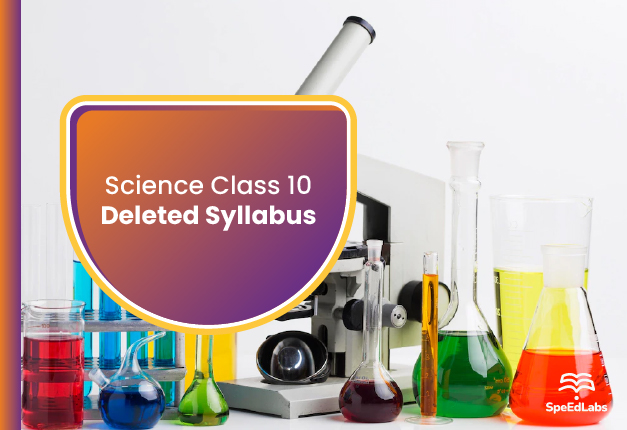CBSE has decided to reduce the syllabus for Class 10. Candidates who are appearing in the CBSE Board Exam in 2023 must be aware of the chapters and topics that have been removed. The CBSE board has removed about 30% of the entire CBSE Class 10 Science Syllabus. To make the exam preparation process simpler for candidates and lighten the workload, some chapters and topics have been eliminated from the CBSE syllabus.
Learn which chapters and subjects will not be covered in the CBSE Class 10 Science Board Exam in 2023. For complete details on the CBSE Science Deleted Syllabus Class 10th 2022–23, read the article through to the end.
CBSE Class 10 Science Deleted Syllabus 2022-23
| Chapter Name | Topics Deleted |
| Periodic Classification
(Full Chapter Deleted) |
Need for classification, early attempts at classification of elements (Dobereiner’s Triads, Newland’s Law of Octaves, and Mendeleev’s Periodic Table), Modern periodic table, gradation in properties, valency, atomic number, metallic and non-metallic properties. |
| Heredity and Evolution | Basic concepts of evolution: evolution; evolution and classification and evolution should not be equated with progress |
| The Human Eye and the Colourful World | Application of scattering in explaining colour change of the sun at sunrise and sunset |
| Magnetic Effects of Current | Electric Motor, Electromagnetic induction. Induced potential difference, Induced current. Fleming’s Right Hand Rule, Electric Generator, |
| Sources of Energy
(Full Chapter Deleted) |
Different forms of energy, conventional and non-conventional sources of energy: Fossil fuels, solar energy; biogas; wind, water and tidal energy; Nuclear energy. Renewable versus non-renewable sources of Energy. |
| Management of Natural Resources
(This chapter will not be assessed in the year-end examination. It needs to be prepared only for Internal Assessment.) |
Conservation and judicious use of natural resources. Forest and wildlife: Coal and Petroleum conservation. Examples of people’s participation for conservation of natural resources. Big dams: advantages and limitations; alternatives, if any. Water harvesting. Sustainability of natural resources. |
All these form the part of CBSE Science Deleted Syllabus Class 10th. Now let us have a look at the syllabus for the Practical Exam.
CBSE Class 10 Science Syllabus 2022-23 for Practical Exam
Please find details on the Class 10 Science practical exam syllabus in this section.
List of Experiments
- A. Finding the pH of the following samples by using pH paper/universal indicator:
(i) Dilute Hydrochloric Acid
(ii) Dilute NaOH solution
(iii) Dilute Ethanoic Acid solution
(iv) Lemon juice
(v) Water
(vi) Dilute Hydrogen Carbonate solution
- B. Studying the properties of acids and bases (HCl & NaOH) on the basis of their reaction with:
- a) Litmus solution (Blue/Red)
- b) Zinc metal
- c) Solid sodium carbonate Unit–I: (Chapter-2)
- Performing and observing the following reactions and classifying them into:
- Combination reaction: Action of water on quicklime
- Decomposition reaction: Action of heat on ferrous sulphate crystals
- Displacement reaction: Iron nails kept in copper sulphate solution
- Double displacement reaction: Reaction between sodium sulphate and barium chloride solutions. Unit-I: (Chapter-1)
- A. Observing the action of Zn, Fe, Cu and Al metals on the following salt solutions:
(i) ZnSO4 (aq)
(ii) FeSO4 (aq)
(iii) CuSO4 (aq)
(iv) Al2 (SO4)3 (aq)
- B. Arranging Zn, Fe, Cu and Al (metals) in the decreasing order of reactivity based on the
above result. Unit-I: (Chapter-3)
- Experimentally show that carbon dioxide is given out during respiration.
Unit-II: (Chapter-6)
- Determination of the focal length of (i) Concave mirror and (ii) Convex lens by obtaining the
image of a distant object. Unit-III: (Chapter- 10)
- Tracing the path of a ray of light passing through a rectangular glass slab for different angles of
incidence. Measure the angle of incidence, angle of refraction, angle of emergence and
interpret the result. Unit-III: (Chapter-10)
- Tracing the path of the rays of light through a glass prism. Unit-III: (Chapter-11)
Now you should keep the CBSE Science Deleted Syllabus Class 10th in your mind.
Also Read –
Also published on Medium.
